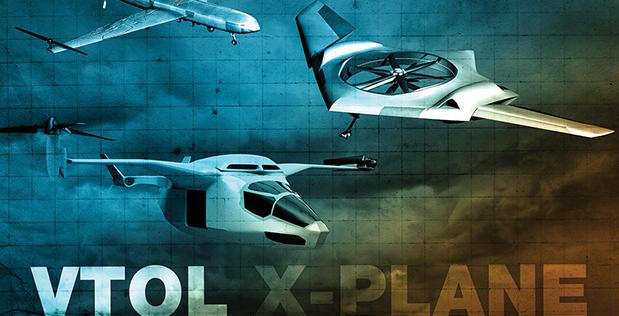 There are pros and cons to both helicopters and airplanes. For many military applications, helicopters have obvious advantages in that they can land and take off from anywhere without needing a runway. However, the speed of helicopters can’t compare with the speed of jets, and that can be a significant liability in terms of mission length and vulnerability to attack. If only there were an aircraft that combined the best of both worlds – the speed of an airplane, plus the vertical takeoff/landing and hovering capabilities of a helicopter.
There are pros and cons to both helicopters and airplanes. For many military applications, helicopters have obvious advantages in that they can land and take off from anywhere without needing a runway. However, the speed of helicopters can’t compare with the speed of jets, and that can be a significant liability in terms of mission length and vulnerability to attack. If only there were an aircraft that combined the best of both worlds – the speed of an airplane, plus the vertical takeoff/landing and hovering capabilities of a helicopter.
The Defense Advanced Research Projects Agency (DARPA) is working on it. In 2013 the agency launched the Vertical Takeoff and Landing Experimental Plane (VTOL X-Plane) project, aimed at developing an aircraft that flies like an airplane but takes off and lands like a helicopter, essentially. It’s been going quite well so far – in March, DARPA selected the prime contractor to work on Phase II of the project, after a several-year design competition that made up Phase I. Aurora Flight Sciences has been developing an experimental VTOL called LightningStrike, in conjunction with partners Honeywell International and Rolls-Royce, and clearly DARPA likes what it sees.
Aurora validated DARPA’s decision on April 18 when they successfully tested a 3D printed scale model of the LightningStrike aircraft. With a wing and canard tail system constructed from carbon fiber and 3D printed thermoplastics, the 20% scale plane only weighs 325 lbs. – a light weight that, without 3D printing, couldn’t have been achieved while maintaining the complex structural elements required.
 LightningStrike is unlike any aircraft ever designed before, in that it utilizes a hybrid-electric propulsion system and a unique synchronous electric-drive system that are expected to allow the plane to greatly surpass the speed and fuel efficiency of any existing VTOL. According to DARPA, VTOLs haven’t yet been capable of reaching a top speed of more than 150-170 knots – just under 200 mph. Ideally, the finished LightningStrike will reach speeds of 300 to 400 knots, or over 450 mph. It’s also expected to have a hovering efficiency of about 60-75% better than any VTOL to date.
LightningStrike is unlike any aircraft ever designed before, in that it utilizes a hybrid-electric propulsion system and a unique synchronous electric-drive system that are expected to allow the plane to greatly surpass the speed and fuel efficiency of any existing VTOL. According to DARPA, VTOLs haven’t yet been capable of reaching a top speed of more than 150-170 knots – just under 200 mph. Ideally, the finished LightningStrike will reach speeds of 300 to 400 knots, or over 450 mph. It’s also expected to have a hovering efficiency of about 60-75% better than any VTOL to date.
The April 18 test showed that the scale model of the aircraft can successfully hover, take off and land vertically. Aurora technicians demonstrated the model via remote control as DARPA officials watched.
“The successful subscale aircraft flight was an important and exciting step for Aurora and our customer,” said Tom Clancy, Chief Technology Officer for Aurora. “Our design’s distributed electric propulsion system involves breaking new ground with a flight control system requiring a complex set of control effectors. This first flight is an important initial confirmation that both the flight controls and aerodynamic design are aligning with our design predictions.”
Aurora Flight Sciences has been flying high lately – a few months before winning the contract from DARPA, they made history with the world’s first 3D printed, jet-powered unmanned aerial vehicle (UAV). From here, it looks like things are going to be moving fast. In the next year, Aurora is going to be working on the full-scale version of LightningStrike, with its first test flights scheduled for 2018. That’s an insanely fast progression from original concept to full testing, and 3D printing is largely to thank for that, enabling Aurora to construct the aircraft’s structural elements at, well, the speed of a lightning strike, so to speak. You can watch one of the early test flights below. Discuss in the Aurora 3D Printed Aircraft forum over at 3DPB.com.
Subscribe to Our Email Newsletter
Stay up-to-date on all the latest news from the 3D printing industry and receive information and offers from third party vendors.
You May Also Like
Gorilla Sports GE’s First 3D Printed Titanium Cast
How do you help a gorilla with a broken arm? Sounds like the start of a bad joke a zookeeper might tell, but it’s an actual dilemma recently faced by...
Nylon 3D Printed Parts Made More Functional with Coatings & Colors
Parts 3D printed from polyamide (PA, Nylon) 12 using powder bed fusion (PBF) are a mainstay in the additive manufacturing (AM) industry. While post-finishing processes have improved the porosity of...
$25M to Back Sintavia’s Largest Expansion of Metal 3D Printing Capacity Since 2019
Sintavia, the digital manufacturing company specializing in mission-critical parts for strategic sectors, announced a $25 million investment to increase its production capacity, the largest expansion to its operations since 2019....
Velo3D Initiates Public Offering in a Bid to Strengthen Financial Foundations and Drive Future Growth
Velo3D (NYSE: VLD) has been among a number of publicly traded 3D printing firms that have attempted to weather the current macroeconomic climate. After posting a challenging financial report for 2023,...

































